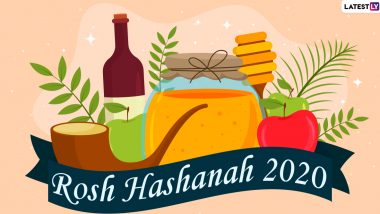Rosh Hashanah which means the "head of the year" or "first of the year" is the Jewish New Year. It begins on the first day of Tishrei, the seventh month of the Hebrew calendar. It corresponds with the Gregorian months of September of October. Rosh Hashanah 2020 begins on September 18 and ends on September 20. The observance was likely well established in the sixth century B.C. as the phrase “Rosh Hashanah” shows up for the first time in the Mishna, a Jewish code of law compiled in 200 A.D. Share Jewish New Year Greetings L'shanah Tovah in Hebrew, Quotes, GIF Images, WhatsApp Stickers, Facebook Messages and Instagram Posts With Family & Friends.
Traditions, Food, Customs And Practices
Rosh Hashanah begins by blowing of the Shofar, an instrument made with a ram's horn, starts off the celebration. It is believed to be a commandment by God to wake up hearing the horn on each morning of the holiday. People blow it 30 times during the morning Torah-reading. Women and girls light the candles on each evening of Rosh Hashanah and recite blessings. On the second night, they use the flame from existing fire to light their candles. As they light the candles, they may recite the Shehechiyanu blessing.
Families will eat a festive meal every night of the festival. They begin the feast by the blessing over the bread. Some of the traditionally prepared dishes for the festival include fish, pomegranates, honey, and other fruits.
Believers read the Torah on both mornings of Rosh Hashanah. On the first day, they read about Isaac's birth and banishment of Hagar and Ishmael, followed by a reading of Samuel the Prophet. The prayers are based on the occasion in scripture. On the second morning, observers read about Abraham's symbolic sacrifice of his son, Isaac. It is believed that blowing the Shofar evokes the ram, which features in the story.
Rosh Hashanah Greetings
People greet each other Rosh Hashanah, saying, "Leshana tovah tikatev v’tichatem," for men, and "Leshana tovah tikatevee v’tichatemee" for women. The first phrase says "may you be inscribed and sealed for a good year”, and afterwards people wish others a “G’mar chatimah tovah”, which means “a good inscription and sealing [in the Book of Life]”. As a customary practice, believers toss a handful of breadcrumbs into flowing water to represent the casting off of their sins. Throwing the crumbs is also symbolically commences fasting and self-reflection that precedes Yom Kippur.
(The above story first appeared on LatestLY on Sep 15, 2020 04:53 PM IST. For more news and updates on politics, world, sports, entertainment and lifestyle, log on to our website latestly.com).













 Quickly
Quickly




















